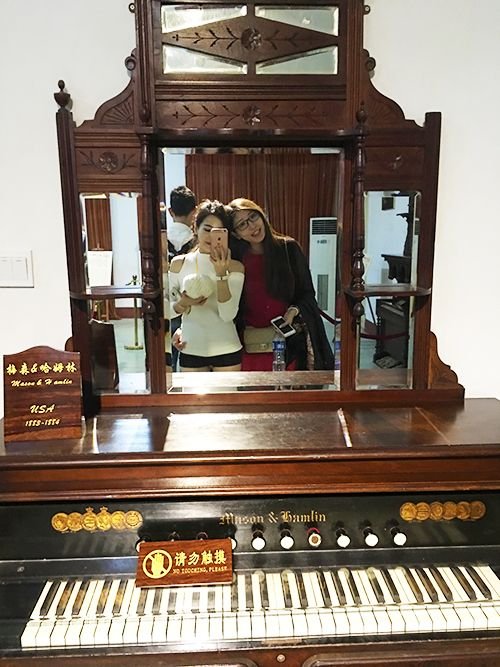Dear Steemit Friends:
Today, we'll be visiting the Gulangyu scenic island just off the coast of Xiamen. You might be wondering where the Gulangyu name comes from? Well, in Chinese, it literally means Drum Sounding Wave Islet. That should be a clue as to why this island is called Gulangyu, as one visit to the coast will show how loudly the waves coming in at the tide will drum on the reef below. A very distinctive sound that has now become the descriptor and name for this beautiful island. Gulangyu is known for it's criss-crossed narrow and short streets, it's also Xiamens' largest satellite island.

After browsing perhaps around half of one of the bustling streets, I found myself to be quite tired. It must have been due to my busy schedule and also the climate of Gulangyu which like Xiamen is very humid and very warm all year round. As if to save me, I came across this Oyster Omelette stall by way of smell and it literally revitalised me there and then! Let's see what all the fuss is about..
Oysters are a special local produce. As an island, seafood is naturally one of the main delicacies here. The Omelette here reminds me very much of the kind you'll find in Taiwan called "蚵仔煎" or Oyster Omelette.
Aside from the round little oysters (you can also choose prawns) which are added to the round and integrated frying pan, you'll also see chopped onions, secret seasoning and some other condiments being added as the omelette takes shape.
When the omelette is just about ready, the final condiments and seasoning are added along with the vegetables. It is then up to you if you want to add some spice, chilli sauce or other condiments to your own liking.
Even though the omelette is already itself made out of egg, I love to have it along side some traditionally fried egg as well as some cucumber. I'll also add a fair amount of sweet and sour chilli sauce which for me make the whole dish taste just that much more delicious!
Fried Prawn Balls.
These are pan fried oyster steamed dumplings. They look quite a lot like the Shanghai Pan fried Steamed Dumplings but inside, instead of pork, we have oysters! Me and my friends started off with one portion and quickly realised it wasn't enough. We ended up having another!
Of course, after eating quite a bit of food, it was time to go back to walking and kick start the digestion! I found this really rather splendid looking tree with a very large and wide area crown. Ideal for sitting under cover from the sun.
1
This is a very pretty stone gaurdian lion.
This is a very popular and famous point of interest on Gulangyu called the Sunlight rock cliff. It is 92.7m above sea level, and serves as both a monastery / temple and also a cave to go to avoiding the summer heat.
1
1
A water fountain for helping with cooling off.
Everywhere is full of flowers and vegetation, just like a garden.
A very gaily coloured mail box.
A very old house which I think is not used to live in anymore.
With such warm temperature, even the dogs are just chilling on the concrete floor.
1
Path in the woods.
Even with such narrow paths, there are still people with stalls.
There are many tourists at the beach.
There are also some water sports activities for those with an appetite for some extreme water sports.
Here is a picture of me and my girl friends up high.
.jpg)
1
Shuzhuang Garden was built in fairly recent history, just over 100 years ago. It's considered a cultural relic and is a protected site. It used to serve as a villa for a private wealthy family.
Here is one of my favourite places in Gulangyu. As you can see by the rocks and above the water, we have this long path. It is made tiny stations connected by 44 bridges. The 44 bridges are significant because that is the age of the architect when this was designed.
1
Beneath one of the bridges, we can see the Sluice gates which are used to help bring the water up into the garden complex.
Here are some very mysterious but wonderful looking rocks.
1
Next up, let's take a look at Gulangyu's special organ museum

Here is the very grand and unique looking organ museum. Inside, the museum has around 40,000 square meters of floor space, and was actually built to house one of the enormous organs which we will see in just a moment. The building itself is constructed against the side of a mountain and faces the sea. Some of the best views of the island beach can be seen from here.
I wonder if any of my steemit friends play the organ, having learned to play the piano, I still know very little about how an organ works..
Various old antique organs really set the sentiment and mood back in time.
This instrument from the outside looks like a wardrobe at first, but actually it is a percussion instrument from Australia, not an organ at all. Usually this instrument is placed inside a church and it can take the place of a whole clock tower!
I'm starting to get really confused and lost with so many different varieties of Organs.
1
1
1
1
1
1
1
Here are some organ souvenirs.
This organ here is made by Norman and Beard in England in 1909.
This is the enormous pipe organ I mentioned earlier for which this museum building was built especially for. It stands 6 meters tall, and has a total of 1350 pipes!
There are 3 keyboards and at the time represented the pinnacle of organ engineering.
It is quite rare to see such a well preserved and working specimen. This was one of the first organs which could be both powered by hand as well as electricity.
I was really quite astonished to see it up close. I really wanted to have a try for myself. Of course it's long been decommissioned for use.
1
Here is a picture from the side of the organ. As you can see, it's inner workings are very very complicated!
Below, we have some very strange and interestingly shaped organs.
This is what it looks like on the side. It seems the organ can be played by reading the punch hole cards.
The top part.
1
1
1
1
1
1
1
1
Some of the organs have also been used as a dressing table when the keyboard part is covered. I thought I could get a cheeky selfie with me and my friend in front of the dressing table mirror!

1
On the way out, I bump into my new furry canine friend.
1
And that concludes my episode on Gulangyu's street food and the special organ museum. That will not be all from Gulangyu however, as in my next post about Gulangyu, i'll be introducing yet another very musically themed point of interest. Stayed tune, and see you all very soon!
今天我想继续带朋友们去游玩厦门的鼓浪屿,鼓浪屿之所以叫这个名字,是因为这片水域浪潮水涌,浪击打着礁石的声音就像打鼓,所以叫做鼓浪屿。岛上的街道密集而短小,纵横交错,是厦门最大的一个卫星岛之一。
我和朋友逛到一半有些疲劳,闻到街边传来香喷喷的香煎牡蛎的味道,立刻就好精神。下面我们一起来看看这个厦门美食的制作过程吧。牡蛎一直都是海边的特产,而这个做法和台湾的美食偶阿煎有点像。除了在圆圆的锅里放上一颗颗牡蛎,还加了鸡蛋,葱花,各种秘制酱料,放在一起煎。在快煎好的时候放上调料,配上蔬菜,再自选上辣椒以及其他佐料,就可以开吃啦。吃的时候我喜欢鸡蛋,牡蛎和黄瓜一起吃,蘸上酸甜的辣椒,味道鲜美,好吃极了。煎虾,虾的尾巴翘起来,姿势好漂亮。香煎牡蛎小笼包,样子看上去有些像上海的生煎包,实际上里面放的可是鲜美的牡蛎哦。我们几个吃的都挺不下来了,后来一盒不够,又去买了一盒。吃完之后当然要去走一走消食,岛上的苍天大树帮助整个广场上的人们遮荫。这是鼓浪屿的著名景点日光岩,海拔92.7米,里面不仅有寺庙还有避暑洞。菽庄花园是鼓浪屿上的近代建筑也是文物保护对象,曾经是私人别墅。很喜欢岩石边这条长长的水上通道。这是四十四桥,是全园区的主要景物,因为主人建桥时44岁而得名。桥的下面有闸门,将海水引入园区。
接下来我想带大家去看看鼓浪屿著名的风琴博物馆。走进这个很有特色的建筑里。风琴博物馆占地4万多平方米,为安放一架巨型管风琴而建的鼓浪屿风琴博物馆处于鼓浪屿的中部,依山面海风景好极了。不知道steemit的朋友们有没有会凤琴的,学过钢琴的我也只是对凤琴略知一二。各种古老的风琴好有情调。这个琴的外形好像衣柜,其实他是产自澳大利亚的排钟琴——一种打击乐器,而不是风琴。一般放在教堂里,可以代替整个钟楼。各式各样的风琴看花了眼。这台风琴叫做Norman&Beard,产自1909年英国。这就是传说中的巨型风琴,它高达6米,由1350根音管组成。有3层键盘,是20世纪初世界管风琴的巅峰作品。有难得保存完好的手摇风箱系统,是世界上少有既可以电力鼓风又可以人力鼓风的风琴。我看到的时候真的好震惊,好希望可以自己亲自试一试怎么摇风箱。我还特意拍了它的侧面,里面工序复杂。接下来是一些拥有特别形状的风琴。今天的风琴博物馆旅程就到这里吧,下次还有鼓浪屿上最大的钢琴博物馆在等着与大家分享!
